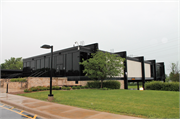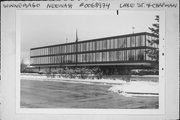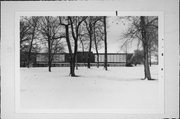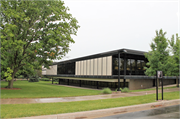Property Record
401 N LAKE ST
Architecture and History Inventory
| Historic Name: | KIMBERLY-CLARK HEADQUARTERS |
|---|---|
| Other Name: | Kimberly-Clark North Office; Kimberly-Clark Dormitory |
| Contributing: | |
| Reference Number: | 68974 |
| Location (Address): | 401 N LAKE ST |
|---|---|
| County: | Winnebago |
| City: | Neenah |
| Township/Village: | |
| Unincorporated Community: | |
| Town: | |
| Range: | |
| Direction: | |
| Section: | |
| Quarter Section: | |
| Quarter/Quarter Section: |
| Year Built: | 1956 |
|---|---|
| Additions: | |
| Survey Date: | 19882019 |
| Historic Use: | large office building |
| Architectural Style: | International Style |
| Structural System: | Steel Frame |
| Wall Material: | Metal |
| Architect: | Skidmore, Owings & Merrill |
| Other Buildings On Site: | Y |
| Demolished?: | No |
| Demolished Date: |
| National/State Register Listing Name: | Not listed |
|---|---|
| National Register Listing Date: | |
| State Register Listing Date: |
| Additional Information: | Kimberly-Clark Dormitory and office - the ground-level main story of this steel-framed Miesian International Modern building overhangs an exposed basement story. The entry in the upstream, south facade, shielded by a deep overhang of the flat roof, is approached by an open staircase with cement treads. The building is internally framed and surrounded with glass curtain walls subdivided by narrow mullions. A beamed truss visible above the center bays of the landward, west sidewall suggests the presence of an interior space fitted with a clerestory or as an atrium. A shallow upstream, rear balcony matches that at front and is linked by walkways to buildings on the northern perimeter of the complex. Fox River Valley Industrial Survey The Kimberly-Clark Company was established in Neenah by John A. Kimberly, Havilah Babcock, Charles B. Clark, and Frank C. Shattuck in 1872. The company’s first venture was the non-extant Globe Mill in Neenah, which was the first mill in the state to produce newsprint entirely from linen and cotton rags. The company acquired the adjacent Neenah Paper Mill in 1878, which was replaced in the same location with a new mill complex in 1885. Kimberly-Clark also established the Atlas and Telulah Mills in Appleton during the 1880s, during which time the company had become the largest paper manufacturer in the Midwest. Another new mill, along with the construction of an entire community, was established in Kimberly in 1889. Additional mills were either purchased or constructed in DePere, Quinnesec Falls, Niagara, New York and Philadelphia, Pennsylvania during the 1890s. The company reorganized and incorporated as the Kimberly-Clark Company in 1906. The company established a research, technical, and engineering department in 1914, which would go on to propel the company to further successes as it developed cellucotton products that could readily be made into popular consumer goods such as toilet papers, sanitary papers, disposable soft papers, and absorptive papers for brands like Kleenex and Kotex. The Kimberly-Clark also began expanding its marketing outside of the United States during the 1920s. The company continued to expand, using its scale and the popularity of its marketing campaigns to aid its consumer goods empire during the 1930s and 1940s. During the 1950s, the company embarked on a series of expansions including the acquisition of eight paper mills in Canada and the United States. Kimberly-Clark also invested in facilities outside of North America for the first, time, expanding into Mexico, United Kingdom, and France. In 1953, Kimberly-Clark began planning for a new headquarters in Neenah. The Kimberly-Clark Headquarters building was constructed at 401 North Lake Street in Neenah in 1956. The building included three distinct sections: the two-story executive wing, the main office wing, and cafeteria and could host 800 employees. The building was designed by the Chicago architecture firm of Skidmore, Owings, and Merrill (SOM) in the International style. The headquarters building and campus was widely published in architectural magazines at the time and arguably became a model for future corporate campus work by SOM. The architecture firm had developed a close relationship with Kimberly-Clark in Neenah, designing a large paper mill warehouse expansion in the 1930s, the home of one of the company’s presidents, and the local bank. The building was constructed by local contractor Meyer Corporation and features an internal steel frame, flat roof, wide expanses of glazing, pebble-dash panels, and interior courtyards. During the 1960s, Kimberly-Clark’s success continued with additional expansions, the introduction of products such as Kleenex tissues, and the first trial tests of disposable diapers. Cottonelle brand, Wypall Wipes, and Huggies were introduced, and the company began the process of moving away from traditional rolled paper manufacturing, closing some of its plants across the United States in the 1970s. In 1980, the company moved its U.S. Service Products and Nonwoven Business Division from Neenah to Roswell, Georgia, and in 1985, Kimberly-Clark moved its headquarters from Neenah to Irving, Texas. Since that time, the Kimberly-Clark Headquarters building has served as office space for the corporation. Since the 1980s, the company introduced disposable training pants, premium bathroom tissue, baby wipes, underpants, disposable swim diapers, and a series of medical products while also acquiring the Scott Paper Company and becoming one of the largest consumer product corporations in the world. The Kimberly-Clark Headquarters is significant under Criterion C: Architecture as an excellent example of a mid-twentieth century modern corporate campus. It is also significant under Criterion A: History in the area of Industry for its role in the Neenah paper industry. The period of significance for the property would extend from 1956 to circa 1970, approximately fifty years ago. |
|---|---|
| Bibliographic References: |
| Wisconsin Architecture and History Inventory, State Historic Preservation Office, Wisconsin Historical Society, Madison, Wisconsin |





